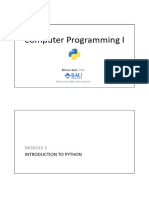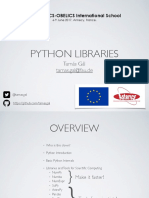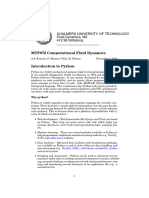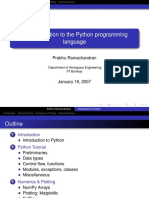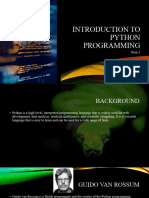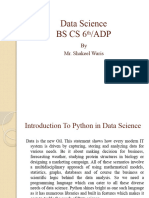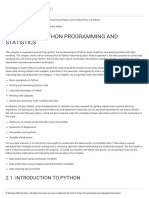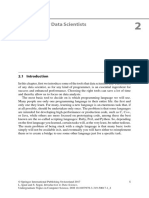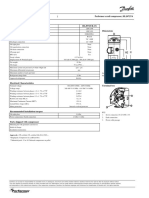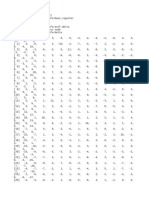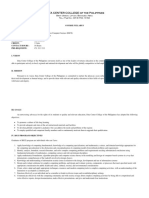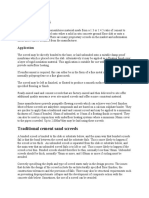Introduction to Python 3
Chang Y. Chung
May, 2015
�Shh
I Python is . . .
1 / 22
�Shh
I Python is . . .
I slow.
1 / 22
�Python is slow
I A tight loop like below runs 10 to 100 (or more) times
slower than C or java.
1 total = 0
2 f o r i in range(1000):
3 f o r j in range(1000):
4 t o t a l += i # how many times this statement runs?
5
6 print total
7 # 499950000000
2 / 22
�Python is slow
I A tight loop like below runs 10 to 100 (or more) times
slower than C or java.
1 total = 0
2 f o r i in range(1000):
3 f o r j in range(1000):
4 t o t a l += i # how many times this statement runs?
5
6 print total
7 # 499950000000
I Although you can re-write the above and make it run
almost, but not quite, as fast.
1 p r i n t sum([1000 * i f o r i in xrange(1000)])
2 # 499950000000
2 / 22
�Why is Python slow
I Interpreted, not compiled.
I Almost no automatic optimization.
I High-level, versatile programming constructs tend to be
larger, more complicated, and slower.
I A simple piece of code may have a huge performance
implication. e.g. range(1000) creates and returns a
1000-element list every time it is called.
3 / 22
�Why Python is not slow
I Faster programming constructs (e.g., xrange() vs. range(),
comprehension vs. for loop)
I Modules written in C (e.g., cPickle vs. pickle)
I NumPy and SciPy for scientific computation.
I Python/C API (http://docs.python.org/2/c-api)
I Cython (http://cython.org) takes Python code and
generates efficient C code.
I PyPy Just-In-Time (JIT) compiler. (http://pypy.org)
4 / 22
�Implementations
I The reference implemention (in C) is called CPython,
which Guido van Rossum authored, starting in 1989
I Guido is also known as Benevolent Dictator For Life
(BDFL. See http://tinyurl.com/5pg99q)
5 / 22
�Implementations (cont.)
I There are other implementations as well.
I IronPython (.NET CLR http://ironpython.net)
I Jython (Java VM http://www.jython.org/)
I pyjs (JavaScript http://pyjs.org/)
I Skulpt (web browser http://www.skulpt.org)
I CodeSkulptor (web browser
http://www.codeskulptor.org)
6 / 22
�Python 2 or 3?
I Python 3.0 (2008) broke backward compatibility.
B Can’t use 2 modules in 3 and vice versa.
I "2 is legacy, 3 is the present and future."
(http://tinyurl.com/omgx9tk)
B 3.4 is expected in early 2014.
B 2.0 was released in 2000.
B 2.7 (2010) will be the last 2.x branch.
I Many of 3’s major futures have been backported to 2.6
and 2.7, but not all.
I Other implementations in general still lack support for
Python 3.
7 / 22
�Editors and IDE’s
I EMACS comes with python.el (24.2 and up) and
python-mode.el (newer). See
(http://tinyurl.com/y67za8d)
I VIM configuration links at http://tinyurl.com/apx3avc
I IDLE (http://tinyurl.com/c7j2k3x)
I (Semi-) commercial editors, e.g., Komodo, PyCharm,
Sublime, . . .
I IPython (http://ipython.org) and IPython notebook.
I And many others. See http://tinyurl.com/leqyjw7.
8 / 22
�IPython and IPython Notebook
I A comprehensive environemnt for interactive and
exploratory computing.
I A “new killer app” back in 2011. 1.0 released in 2013.
Stable version 2.0 in April 2014.
I One of the six core packages of SciPy stack.
9 / 22
�PyPI and pip
I Python Package Index (PyPI) is the repository of software
for Python at http://pypi.python.org/pypi.
I As of a day in Jan 2014, it has about 38,800 packages.
I Python Indexing Project (pip)
(http://www.pip-installer.org) is the standard tool
for installing packages (or modules) from PyPI.
I Some examples of using pip. At the shell prompt:
1 $ pip
2 $ pip list
3 $ pip i n s t a l l SomePackage
4 $ pip i n s t a l l --user SomePackage
5 $ pip i n s t a l l --upgrade SomePackage
6 $ pip uninstall
I Once a package is successfully installed, then you can
import the module within your script.
10 / 22
�Installing SciPy Stack
I It is possible to install all the packages one by one (and
all the dependencies). It could turn out to be tricky.
I An alternative is to download and install free or
commercial distributions. Some names are: Anaconda,
Enthought Canopy, Python(x,y), WinPython, . . .
I See http://www.scipy.org/install.html.
I Check out Wakari.IO (https://www.wakari.io) for
playing with SciPy stack on the cloud, without local
installation.
11 / 22
�Quiz
I Choose the best one that fits each description:
1. Standard module supporting object (de-)serialization,
which is written in C.
2. Compiler that turns Python source into efficient C code.
3. Software tool for installing / managing packages.
4. Benevolent Dictator For Life.
5. Provides a rich architecture for interactive (scientific)
computing. Version 1.0 was released in 2013.
comprehension cPickle CPython Cython Guido van
Rossum IPython Niklaus Wirth Pickle pip Sublime
xrange() Yukihiro Matsumoto
12 / 22
�NumPy
I Provides the ndarray object.
I implements an efficient homogeneous
ndarray
multidimensional array.
I Element-wise and vectorized matrix operations are
provided.
I Lots of modules use / built on NumPy.
I Documentation at http://docs.scipy.org/doc.
13 / 22
�SciPy
I Collection of mathematical algorithms and utility
functions built on NumPy.
I Organized into subpackages: cluster, constants, fftpack,
integrate, interpolate, io, linalg (linear algebra), ndimage
(N-dimentional image processing), odr (orthogonal
distance regression), optimize, signal (signal processing),
sparse (sparce matrices), spatial, special (functions),
stats, weave (C/C++ integration)
I Documentation at http://docs.scipy.org/doc.
14 / 22
�Matplotlib
I Provides comprehensive 2D and simple 3D plotting.
I Simple plot, Subplots (multiple axes), Histograms, Path,
Simple 3D plot (surface, wireframe, scatter, bar),
Streamlines (of a vector field), Ellipses, Bar charts, Pie
charts, Filled (curves and polygons), Financial charts,
Polar plots, . . . , including TeX expressions support
(internal or external) and Sketch plots (XKCD style)
I Screenshots are (with source code) at
http://matplotlib.org/users/screenshots.html.
I Documentation at
http://matplotlib.org/contents.html.
15 / 22
�pandas
I “Python Data Analysis Library” (Release 0.12 as of 2013).
I Series, DataFrame , and Panel objects
I reading/writing data to and from: CSV, text file, Excel,
SQL db, and fast HDF5 (scientific data file formats and
libraries developed at NCSA), JSON, HTML Table, STATA.
I Labeling columns, iteration, Hierarchical Indexing,
Transformation, Selection, Missing Data, Merge, Grouping
(or split-apply-combine), Reshaping (or pivoting), Time
Series, I/O tools, R interface (via rpy2).
I Documentation at http://pandas.pydata.org.
I Wes McKinney, “10-minute tour of pandas”
(http://vimeo.com/59324550) or workshop
(http://www.youtube.com/watch?v=MxRMXhjXZos)
16 / 22
�Learning Resources
I Websites:
B Main website http://www.python.org and SciPy site
http://scipy.org.
B Official Python Tutorial
http://docs.python.org/2/tutorial/index.html.
B Google’s Python Class (2 day class materials including
video and exercises)
https://developers.google.com/edu/python.
17 / 22
�Learning Resources
I Three advanced level tutorial videos:
B technical (old)
http://www.youtube.com/watch?v=E_kZDvwofHY.
B idioms (new)
http://www.youtube.com/watch?v=OSGv2VnC0go.
B functional style
http://www.youtube.com/watch?v=Ta1bAMOMFOI.
B 2000+ videos at http://pyvideo.org.
18 / 22
�Learning Resources
I Books:
B Mark Lutz (2013) Learning Python 5th ed (1,400 plus
pages).
B “6 Free E-Books” mentioned on
http://tinyurl.com/m2y9rad.
B Matthew Russell (2013) “Mining the Social Web” 2nd
edition is out. Example code files (in IPython Notebook file
.ipynb format) are at http://tinyurl.com/n3txeu5.
19 / 22
�Learning Resources
I Any cool computer language has:
B Zen (read and memorize!)
http://www.python.org/dev/peps/pep-0020/
B Koans (unit testing) http://tinyurl.com/7n6yfvn
B Challenges (old) http://www.pythonchallenge.com/
I Need more challenges?
B Try the Project Euler http://projecteuler.net
20 / 22
�Learning Resources
I MOOC’s using Python extensively:
B “Introduction to Computer Science and Programming
Using Python” (edX, http://tinyurl.com/o3pbmc3)
B “Introduction to Interactive Programming in Python”
(Coursera, http://tinyurl.com/c95qh2q)
B “Coding the Matrix: Linear Algebra through Computer
Science Applications” (Coursera,
http://tinyurl.com/awkbdho)
21 / 22
�Learning Resources
I Twitter:
B "teaching python 140 character at a time":
http://twitter.com/raymondh
I Gallery
B IPython Notebook gallery (including social data)
http://tinyurl.com/c5tj9xh
22 / 22
